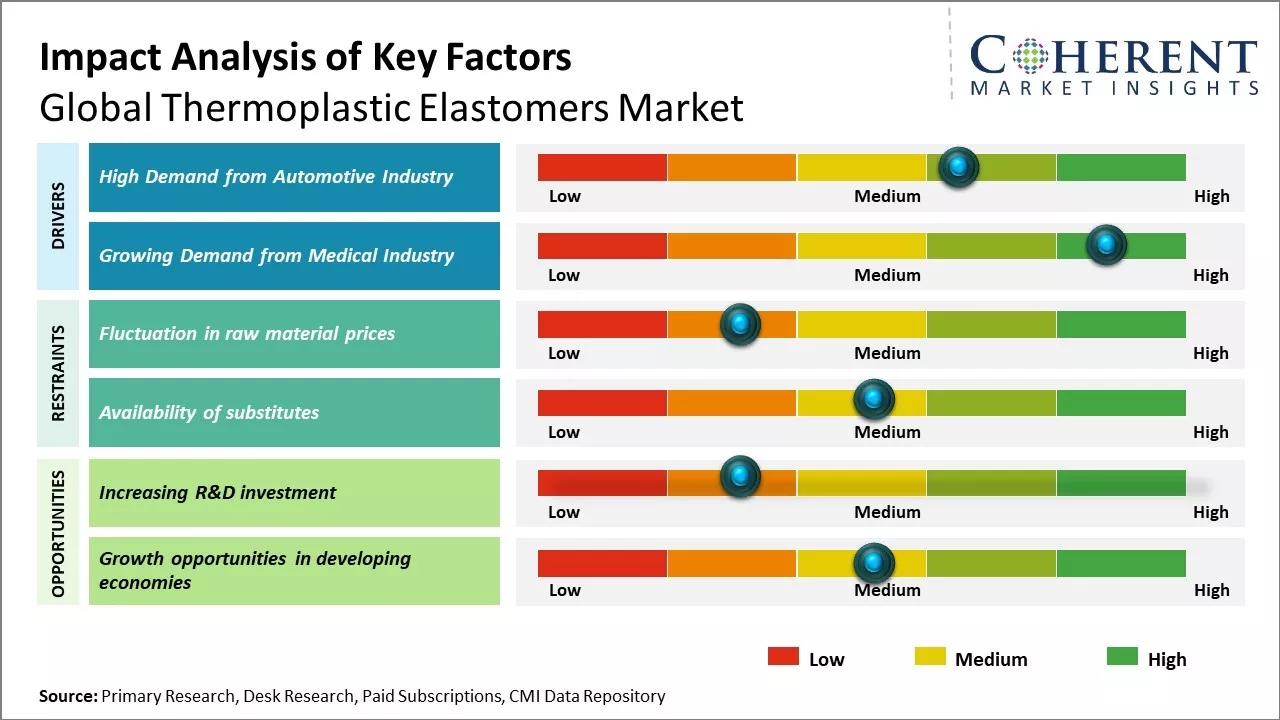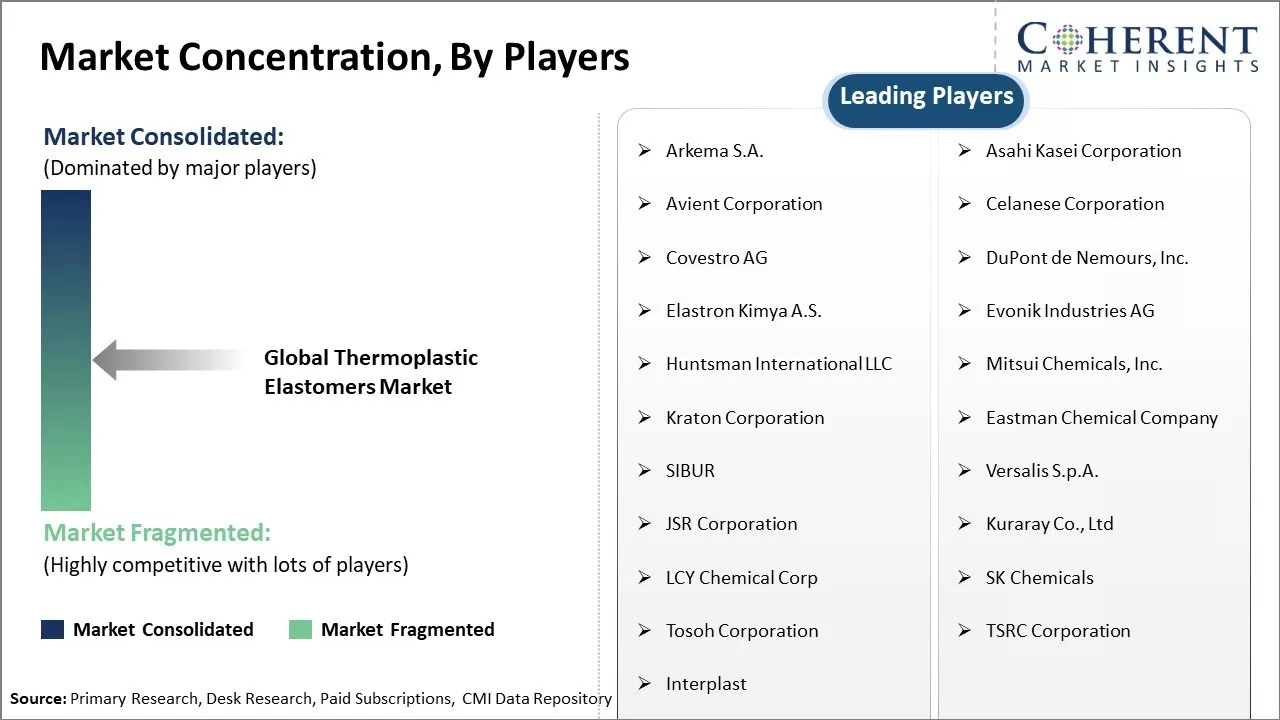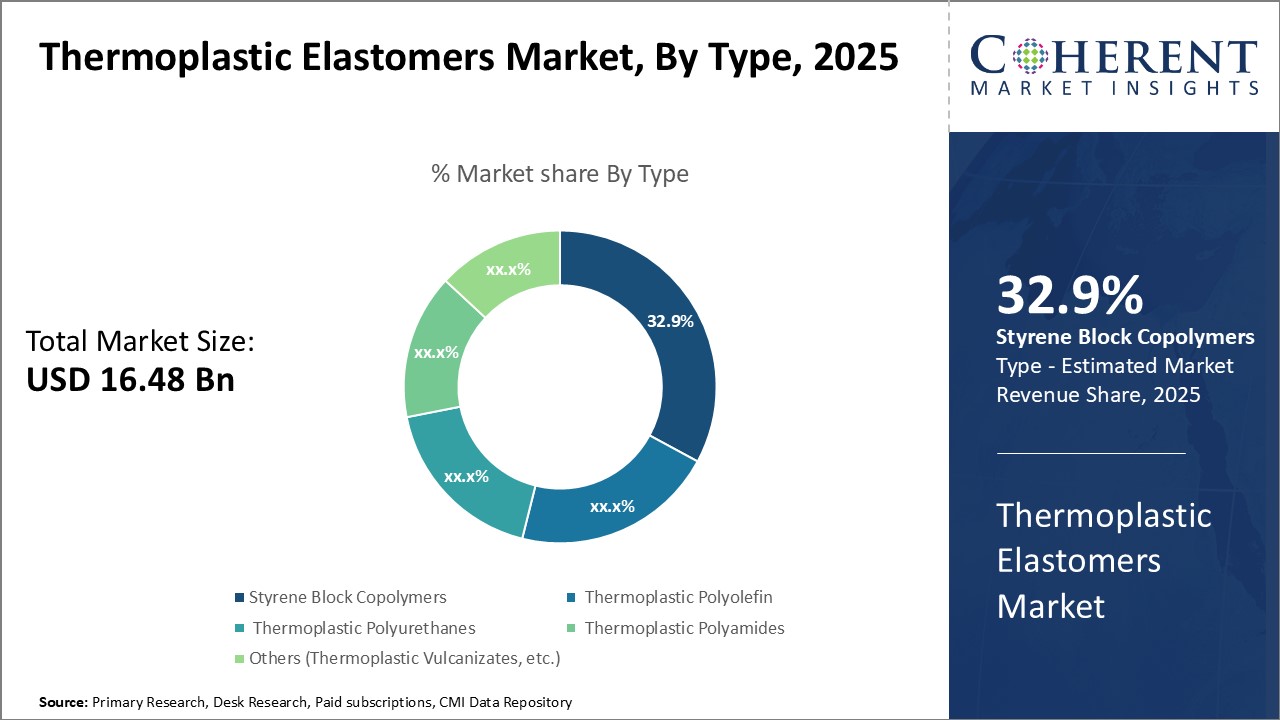The thermoplastic elastomers market is estimated to be valued at USD 16.48 Bn in 2025 and is expected to reach USD 27.18 Bn by 2032, exhibiting a compound annual growth rate (CAGR) of 7.4% from 2025 to 2032.

Discover market dynamics shaping the industry: Request sample copy
Thermoplastic elastomers find wide application in the automotive, construction, footwear, and healthcare industries. Their advantages over conventional rubbers like vulcanizates in terms of recyclability and design flexibility are driving the market growth. The market is witnessing high demand from the automotive industry as OEMs emphasize on light-weighting vehicles. Thermoplastic elastomers are replacing other materials in various interior and exterior automotive applications due to advantages such as easy processing, better design flexibility, and cost competitiveness. Rising vehicle production and sales globally is expected to boost the consumption of thermoplastic elastomers in the coming years.
High Demand from Automotive Industry
The automotive industry has shown significant demand for thermoplastic elastomers in recent years. Automakers are under increasing pressure to make vehicles lighter and more fuel efficient in order to meet stringent corporate average fuel economy standards around the world. Thermoplastic elastomers help automakers achieve this goal as they can be utilized to create lighter weight parts that still provide strength and durability. Many newer vehicle models are incorporating more thermoplastic elastomers into components such as bumpers, fascia, interior panels, seals, and cable insulation. Their superior impact resistance properties make them well suited for panels that see everyday abuse like bumpers. Additionally, their design flexibility allows for more complex part consolidation which reduces overall part count. This directly cuts costs for automakers. With fuel efficiency and emission targets expected to become even more stringent, it is likely automakers will continue to increase their usage of thermoplastic elastomers to slim down vehicle weights in the coming years.

Get actionable strategies to beat competition: Request sample copy
Growing Demand from Medical Industry
The medical industry has emerged as a significant end use segment for thermoplastic elastomers as well. Manufacturers are utilizing these materials for a variety of medical devices and applications due to advantages such as flexibility, improved tactile properties, and excellent chemical resistance. Catheters, tubing, and other implantable medical devices are making extensive use of thermoplastic elastomers. Their flexibility and low tackiness reduce patient discomfort compared to other materials. They also provide improved sealing for enteral feeding tubes. The material is seeing strong demand for use in stopcocks, syringe plungers, tubing for respiratory applications, and other components that come into contact with human skin or tissues. Thermoplastic elastomers are easier to sterilize than natural rubber goods, reducing the risk of contamination or infection. With the global population aging significantly, medical device usage is projected to keep growing substantially in the coming decades. As a result, the demand for high performance elastomers like thermoplastic elastomers is expected to keep rising sharply to support this industry.
Key Takeaways from Analyst:
Increasing demand from the automotive industry for lightweight and durable materials and a rise in polyethylene and polypropylene grafted with rubber drives the market. However, availability of cheaper alternatives such as PVC and natural rubber could restrain market expansion.
North America currently dominates the global market and is expected to retain its leading position throughout the forecast period. This is attributed to a well-established automotive industry in the U.S. and Canada as well as high demand from the medical sector. Europe is also a prominent thermoplastic elastomers market, driven by favorable industrial regulations regarding the use of environment-friendly materials.
The Asia Pacific region is estimated to be the fastest-growing market over the next few years. This is due to rapid industrialization, mounting vehicle production, and improving economic conditions in various countries of the region such as China, India, Thailand, and Indonesia. Moreover, shifting of automotive component manufacturing bases to Asia Pacific will further drive the regional market growth.
Market Challenges: Fluctuation in raw material prices
Fluctuations in the prices of raw materials have been posing challenges for the growth of the global thermoplastic elastomers market recently. Thermoplastic elastomers are polymers that have both thermoplastic and rubber-like properties. They are primarily derived from petrochemical sources and require raw materials such as crude oil, natural gas and their derivatives.
Market Opportunities: Increasing R&D investment
Investing more heavily in research and development could open up tremendous opportunities for growth in the global thermoplastic elastomers market. Thermoplastic elastomers are a versatile class of polymers with applications across many industries, however they still have unrealized potential. With dedicated R&D efforts, manufacturers may be able to expand the material's performance capabilities, enabling new end uses. For example, developing thermoplastic elastomers with enhanced mechanical strength, resistance to chemicals and solvents, or operating temperatures could result in their adoption in more demanding applications like automotive under-the-hood components. This would represent a major market expansion.

Discover high revenue pocket segments and roadmap to it: Request sample copy
Insights by Type: Superior Performance Properties Drive the Demand for Thermoplastic Polyamides
In terms of type, thermoplastic polyamides is expected to contribute 32.9% share of the market in 2025 owing to their superior performance properties. Thermoplastic polyamides, often referred to as nylon, offers a balance of strength, toughness, and resistance to abrasion. They exhibit high elasticity even at low temperatures and have good dimensional stability. Their mechanical properties make them suitable for applications requiring durability, impact resistance and flexibility. Thermoplastic polyamides also demonstrate outstanding chemical resistance to acids, alkalis, oils, and solvents. This chemical resistance allows them to maintain mechanical integrity in harsh environments encountered in various industries. Their resistance to degradation from UV rays further expands their usage outdoors. The self-lubricating nature of thermoplastic polyamides reduces friction and wear, lowering energy consumption. From an engineering perspective, thermoplastic polyamides can be formed into complex shapes using manufacturing techniques like injection molding and extrusion. This allows for precise designs and tight tolerances. They also enjoys advantages like ease of processing, recyclability and relatively low costs of production. The material performs well across a wide range of temperatures from cryogenic to elevated heat. Ongoing industrial automation is enabling higher performance requirements from materials. Thermoplastic polyamides meet these advanced needs through their unique blend of thermal and mechanical properties. Their combination of attributes has resulted in widespread adoption across industries like automotive, packaging, electronics, and 3D printing. This widespread usage underpins thermoplastic polyamides higher market share compared to other thermoplastic elastomer types.
Insights by Application: Robust Growth in the Sealants and Coatings Sector Drives Demand
In terms of application, sealants and coatings is expected to contribute 30.3% share of the market in 2025, due to robust growth in this sector. Sealants and coatings play an important protective role by bonding, sealing, adhering, or protecting various surfaces. The sealing and bonding performance of these products is crucial to many industrial and consumer applications. Tightening environmental regulations have increased focus on developing sustainable sealants and coatings. Thermoplastic elastomers meet this demand through advantages like reduced VOC emissions, recyclability and compatibility with automated production lines. Their versatility allows formulating high-performance products with tailored properties. This customization gives thermoplastic elastomers an edge over alternatives. Growth in the construction industry has strengthened demand for sealants and coatings that deliver weatherproofing, high bonding strength and flexibility. Thermoplastic elastomers match these performance requirements and offer cost-effective solutions. In the automotive sector as well, the need for lightweight yet durable sealants and coatings translates to increased thermoplastic elastomer consumption. More broadly, the overall expansion of manufacturing industries necessitates protective and aesthetic coatings & treatments. Thermoplastic elastomers fulfill this need through products like anti-corrosion coatings, sound damping formulations, and abrasion-resistant sealants. This link to industrial growth underpins the strong market position of the sealants and coatings application segment.
Insights by End-use Industry: Wide Range of Use Drives the Predominance of the Automotive End-use Sector
In terms of end-use industry, automotive is expected to contributes 32.7% share in 2025, due to the wide range of in-vehicle applications for thermoplastic elastomers. Integrating more functional components while reducing weight is a priority for automakers. Thermoplastic elastomers enable achieving these goals through single-material engineering. They offer design versatility for use in bumpers, mud flaps, door and window seals, and other exterior automotive parts. In such exterior uses, they protect against weathering, corrosion, and impact while sealing openings. As under-hood and powertrain components, they provide vibration dampening and insulation. Similarly, in hoses and tubing, they combine flexibility with resistance to heat, fluids and fuels. Thermoplastic elastomers also feature prominently in fast-growing automotive technologies like electronic controls, sensors, and connectivity modules. Their material properties make them suitable for dynamic applications involving vibration isolation and sealing of electrical components. As vehicles trend towards autonomous functionality, demand will increase for high-performance thermoplastic elastomers. Compounded with reinforcing agents, thermoplastic elastomers strengthen interior components such as dashboards, consoles, and airbag doors. Their advantages of recyclability and moldability align with the automotive industry's shift towards more sustainable manufacturing. Combining these advantages with other attributes has enabled automotive applications to emerge as the major end-use sector for thermoplastic elastomers.

Need a Different Region or Segment? Customize now
North America has established itself as the dominant regional market for thermoplastic elastomers. The region is expected to account for 37.2% of the market share in 2025. The region accounts for the largest share of the global market owing to its well-established automotive and medical device industries. These sectors are the primary end-users of thermoplastic elastomers in North America given their need for materials that offer flexibility, resilience and durability. Leading automakers have production facilities dispersed across the U.S. and Canada near their major customer bases and supplier networks, driving consistent demand. Additionally, stringent regulations favor domestic production and the region promotes innovation, attracting investments by global raw material suppliers, and thermoplastic elastomer manufacturers. This ensures ease of availability and competitive pricing.
The Asia Pacific region has emerged as the fastest growing regional market for thermoplastic elastomers in recent years. Rapid industrialization and strong economic growth have fueled massive infrastructure development and automobile manufacturing in countries such as China and India. This has augmented the demand for engineering plastics including thermoplastic elastomers from various end-use industries. China, in particular, has taken significant strides to become a dominant manufacturing hub and net exporter, with liberal foreign investment policies and special economic zones attracting global thermoplastic elastomer producers. Furthermore, government initiatives are promoting the use of plastics over conventional materials in applications like automotive, medical, and packaging. The burgeoning middle-class population is driving higher consumption of commodities and consumer goods manufactured using thermoplastic elastomers. This makes Asia Pacific an extremely lucrative regional market, despite competition from Chinese manufacturers.
Thermoplastic Elastomers Market Report Coverage
| Report Coverage | Details | ||
|---|---|---|---|
| Base Year: | 2024 | Market Size in 2025: | USD 16.48 Bn |
| Historical Data for: | 2020 To 2024 | Forecast Period: | 2025 To 2032 |
| Forecast Period 2025 to 2032 CAGR: | 7.4% | 2032 Value Projection: | USD 27.18 Bn |
| Geographies covered: |
|
||
| Segments covered: |
|
||
| Companies covered: |
Arkema S.A., Asahi Kasei Corporation, Avient Corporation, Celanese Corporation, Covestro AG, DuPont de Nemours, Inc., Elastron Kimya A.S., Evonik Industries AG, Huntsman International LLC, Mitsui Chemicals, Inc., Kraton Corporation, Eastman Chemical Company, SIBUR, Versalis S.p.A., JSR Corporation, Kuraray Co., Ltd , LCY Chemical Corp, SK Chemicals, Tosoh Corporation, TSRC Corporation, and Interplast |
||
| Growth Drivers: |
|
||
| Restraints & Challenges: |
|
||
Uncover macros and micros vetted on 75+ parameters: Get instant access to report
*Definition: Thermoplastic elastomers (TPEs) are materials that have both the processing advantages of plastics and the physical properties of rubbers. They are widely used across various end-use industries like automotive, medical devices, construction, wire & cable, and others. TPEs are used as an alternative to thermoset rubber in applications that require rubber-like elasticity but faster production.
Share
Share
About Author
Yash Doshi is a Senior Management Consultant. He has 12+ years of experience in conducting research and handling consulting projects across verticals in APAC, EMEA, and the Americas.
He brings strong acumen in helping chemical companies navigate complex challenges and identify growth opportunities. He has deep expertise across the chemicals value chain, including commodity, specialty and fine chemicals, plastics and polymers, and petrochemicals. Yash is a sought-after speaker at industry conferences and contributes to various publications on topics related commodity, specialty and fine chemicals, plastics and polymers, and petrochemicals.
Missing comfort of reading report in your local language? Find your preferred language :
Transform your Strategy with Exclusive Trending Reports :
Frequently Asked Questions
Joining thousands of companies around the world committed to making the Excellent Business Solutions.
View All Our Clients
US Reciprocal Tax Impact Analysis On Thermoplastic Elastomers Market
Stay updated on tariff changes with expert insights and timely information